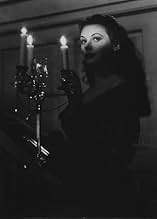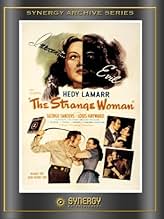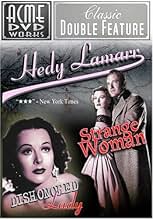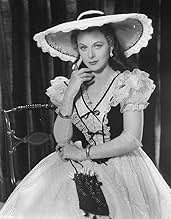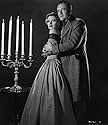IMDb RATING
6.5/10
2.7K
YOUR RATING
In 1820s New England beautiful but poor and manipulative Jenny Hager marries rich old man Isaiah Poster but also seduces his son and his company foreman.In 1820s New England beautiful but poor and manipulative Jenny Hager marries rich old man Isaiah Poster but also seduces his son and his company foreman.In 1820s New England beautiful but poor and manipulative Jenny Hager marries rich old man Isaiah Poster but also seduces his son and his company foreman.
Ed Agresti
- Congregation Member
- (uncredited)
John Alban
- Congregation Member
- (uncredited)
Fred Aldrich
- Sailor in Saloon
- (uncredited)
Jessie Arnold
- Mrs. Thatcher
- (uncredited)
Frank Baker
- Congregation Member
- (uncredited)
Edward Biby
- Mr. Partridge
- (uncredited)
Featured reviews
In the era of psychoanalysis we are forced to look at a figure like the one in this film in a different way. There was a time when villains were at the melodramatic best and we could see them as one dimensional. This young woman is the product alcoholism and manipulation. She has good and she has bad. The bad usually wins out, but then she withdraws into herself, trying to be an ideal. Her relationships with men are certainly influenced by the abusive father from whom she must escape. She toys with men like playthings. She is extraordinarily beautiful. I hadn't ever really seen a Hedy Lamarr film. She about as striking as one can be. It seems that in this era dark haired women were often cast as vixens. She has that role but overcomes it with an excellent performance. It is a nice period piece. It is a little predictable at times, but the wonderful cinematography really pulls it along.
Made just after Hedy had departed MGM when she was still a top star and able to pursue roles with more depth than the glamour assignments handed her by Metro. She was one of the producers of this outing and selected Ulmer as director. Theirs was a contentious partnership but the result was one of Hedy's best performances.
If you can put aside the fact that the lead character has a Viennese accent and her father an Irish one when they are both lifelong natives of Bangor, Maine then there is much to enjoy. Hedy, stunningly beautiful as always, plays a deeply conflicted woman well and though the film veers wildly from morality tale to lurid melodrama it is certainly more fun than a lot of more highly thought of films.
If you can put aside the fact that the lead character has a Viennese accent and her father an Irish one when they are both lifelong natives of Bangor, Maine then there is much to enjoy. Hedy, stunningly beautiful as always, plays a deeply conflicted woman well and though the film veers wildly from morality tale to lurid melodrama it is certainly more fun than a lot of more highly thought of films.
Hedy Lamarr once said that the key to appearing beautiful is 'to stand still and look stupid', but here she proves she could act when required to. As the daughter of a drunk, Jenny has ambitions to rise in the world and become beautiful, using her wiles to subdue and bewitch men into doing her bidding. With a rich and older husband with a weak and easily led son, you can see where this is going, and with people like George Sanders and Louis Hayward supporting her in the cast, Hedy shines in the title role.
A beautifully shot, tightly written film which may have been low budget but has a definite sheen of polish.
A beautifully shot, tightly written film which may have been low budget but has a definite sheen of polish.
An 1820's vixen climbs her way maliciously up the social ladder.
The movie's got the gloss and the casting of a top studio production, maybe TCF. But it's not. Instead, the film is an independent production with Lamarr as a co-producer. I mention this because the result looks tailor-made for a Lamarr career move; at the same time, she does manage to prove she's more than just Hollywood's perfect face. Here, her conniving little vixen (Jenny) transits a number of emotional stages and male victims in fairly convincing style. However, unless I missed something, Jenny's inner guile fails to show up in any of the many close-ups. As a result, Jenny's deceit remains mainly in the script—the one performance flaw.
The movie itself is an atmospheric potboiler, thanks to stylist Edgar Ulmer and art director Remisoff. The scenes may remain stage-bound, but the overall effect is compelling, a triumph of b&w expressiveness. Note too how the scenes get steadily darker as the film progresses and Jenny gets closer to the expected reckoning. Even when the screenplay meanders, which does slow things down, the visuals remain smoothly engaging. Then too, the logging camp setting should have been rethought. The sophisticated Sanders is simply not an outdoor type. Still, wonder of wonders, two of cinema's favorite cerebral baddies, Sanders and Brooke, get sympathetic roles, for a change. Actually, I expected Sanders to break into a cynical sneer at any moment, and maybe Brooke to revert to type with an icy glare. Anyway, it is an interesting cast, down to Hayward as the weakling Ephraim and little Jo Ann Marlowe as the meanest girl since Patty McCormack's Bad Seed (1956).
I don't know if the film resulted in the kind of career break Lamarr was likely looking for, but it remains an entertaining morality tale, despite a spotty script and stage-bound settings.
The movie's got the gloss and the casting of a top studio production, maybe TCF. But it's not. Instead, the film is an independent production with Lamarr as a co-producer. I mention this because the result looks tailor-made for a Lamarr career move; at the same time, she does manage to prove she's more than just Hollywood's perfect face. Here, her conniving little vixen (Jenny) transits a number of emotional stages and male victims in fairly convincing style. However, unless I missed something, Jenny's inner guile fails to show up in any of the many close-ups. As a result, Jenny's deceit remains mainly in the script—the one performance flaw.
The movie itself is an atmospheric potboiler, thanks to stylist Edgar Ulmer and art director Remisoff. The scenes may remain stage-bound, but the overall effect is compelling, a triumph of b&w expressiveness. Note too how the scenes get steadily darker as the film progresses and Jenny gets closer to the expected reckoning. Even when the screenplay meanders, which does slow things down, the visuals remain smoothly engaging. Then too, the logging camp setting should have been rethought. The sophisticated Sanders is simply not an outdoor type. Still, wonder of wonders, two of cinema's favorite cerebral baddies, Sanders and Brooke, get sympathetic roles, for a change. Actually, I expected Sanders to break into a cynical sneer at any moment, and maybe Brooke to revert to type with an icy glare. Anyway, it is an interesting cast, down to Hayward as the weakling Ephraim and little Jo Ann Marlowe as the meanest girl since Patty McCormack's Bad Seed (1956).
I don't know if the film resulted in the kind of career break Lamarr was likely looking for, but it remains an entertaining morality tale, despite a spotty script and stage-bound settings.
For a generation hooked on special effects, and mostly shoddy updates of very old film cliches, 'Strange Woman' must seem like a very dated movie. Of course, that largely depends on generational film tastes. A good story; good if sometimes uneven performances, and of course Hedy Lamarr; one of Hollywood's best kept secrets. Poor Hedy usually got the short end of the stick, as most of the critical acclaim went to very over-rated actresses, who were not nearly as beautiful as Hedy. Critics could never get past her phenomenal beauty, and more often rewarded Bergman, Turner, Davis, and Crawford, because they looked like ordinary everyday people. Oh! the simple minded, one-dimensional critics who imposed their bland tastes on a public, that just craved good entertainment. Hedy as Jenny Hager represents a daring stretch for Hedy; and she delivers a somewhat hammy, but nevertheless engaging performance. George Sanders is excellent as usual, in one of his lesser roles, and the cinematography is first rate. This is a melodramatic melodrama folks! It represents a bygone era in movie-making; when movies were made to entertain, sometimes most effectively in black and white, very often with modest budgets, and without mindboggling effects, extremely loud soundtracks. This movie deserves a 7/10.
Did you know
- TriviaExecutive producer Hunt Stromberg declared his dissatisfaction with the original opening sequence of Edgar G. Ulmer's own daughter Arianne Ulmer who played the young Jenny - she was purportedly not nasty enough - and so he and Hedy Lamarr enlisted Douglas Sirk to re-shoot the scenes using Jo Ann Marlowe who had appeared in Sirk's own Scandale à Paris (1946) earlier that year, and who had also featured as Joan Crawford's daughter Kay in Michael Curtiz' Le roman de Mildred Pierce (1945).
- GoofsEphraim paints "Nöel" rather than the correct "Noël."
- Quotes
Lena Tempest: Honey, listen, with your looks you don't have to worry. You can get the youngest and best-looking man on the pier.
Jenny Hager: I don't want the youngest. I want the richest.
- Alternate versionsLe démon de la chair (1946). Restoration Produced by Jeff Joseph/SabuCat. Digital scan by Film & Video Transfer, Chatsworth, CA. Cineaste Restoration - Thad Komorowski.. Final Conforming & Cleanup by The Finishing Touch. The Strange Woman (Restored Version) copyright 2020 Jeff Joseph/SabuCat.
- ConnectionsFeatured in Edgar G. Ulmer: The Man Off-Screen (2004)
- SoundtracksWhat Can You Do with a Drunken Sailor?
Traditional
Early 19th Century sea chanty
[Heard in tavern]
- How long is The Strange Woman?Powered by Alexa
Details
- Release date
- Country of origin
- Official sites
- Language
- Also known as
- Flor de insidia
- Filming locations
- Production companies
- See more company credits at IMDbPro
- Runtime1 hour 40 minutes
- Color
- Aspect ratio
- 1.37 : 1
Contribute to this page
Suggest an edit or add missing content


